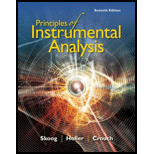
(a)
Interpretation:
The ligand-to-metal ratio in the product should be determined.
Concept introduction:
In the method of continuous variation, cation and ligand solutions which have same concentration are mixed in such a way that total number of moles of reactants and the total volume of each mixture are constant. But the mole ratio varies. Then the absorbance of the mixture is measured and absorbance is corrected. The corrected absorbance is plotted against volume fraction of one reactant. A maximum or a minimum occur at metal to ligand volume ratio equals to the combined ratio of metal to ligand.
(b)
Interpretation:
Average molar absorptivity of the complex and its uncertainty should be calculated.
Concept introduction:
In the method of continuous variation, cation and ligand solutions which have same concentration are mixed in such a way that total number of moles of reactants and the total volume of each mixture are constant. But the mole ratio varies. Then the absorbance of the mixture is measured and absorbance is corrected. The corrected absorbance is plotted against volume fraction of one reactant. A maximum or a minimum occur at metal to ligand volume ratio equals to the combined ratio of metal to ligand.
(c)
Interpretation:
Kf for the complex should be determined
Concept introduction:
In the method of continuous variation, cation and ligand solutions which have same concentration are mixed in such a way that total number of moles of reactants and the total volume of each mixture are constant. But the mole ratio varies. Then the absorbance of the mixture is measured and absorbance is corrected. The corrected absorbance is plotted against volume fraction of one reactant. A maximum or a minimum occur at metal to ligand volume ratio equals to the combined ratio of metal to ligand.
Trending nowThis is a popular solution!

Chapter 14 Solutions
Principles of Instrumental Analysis
- What is the final product when D-galactose reacts with hydroxylamine?arrow_forwardIndicate the formula of the product obtained by reacting methyl 5-chloro-5-oxopentanoate with 1 mole of 4-penten-1-ylmagnesium bromide.arrow_forwardIn the two chair conformations of glucose, the most stable is the one with all the OH groups in the equatorial position. Is this correct?arrow_forward
- please help me with my homeworkarrow_forwardhelparrow_forwardThe temperature on a sample of pure X held at 1.25 atm and -54. °C is increased until the sample boils. The temperature is then held constant and the pressure is decreased by 0.42 atm. On the phase diagram below draw a path that shows this set of changes. pressure (atm) 2 0 0 200 400 temperature (K) Xarrow_forward
- QUESTION: Answer Question 5: 'Calculating standard error of regression' STEP 1 by filling in all the empty green boxes *The values are all provided in the photo attached*arrow_forwardpressure (atm) 3 The pressure on a sample of pure X held at 47. °C and 0.88 atm is increased until the sample condenses. The pressure is then held constant and the temperature is decreased by 82. °C. On the phase diagram below draw a path that shows this set of changes. 0 0 200 temperature (K) 400 аarrow_forwarder your payment details | bar xb Home | bartleby x + aleksogi/x/isl.exe/1o u-lgNskr7j8P3jH-1Qs_pBanHhviTCeeBZbufuBYT0Hz7m7D3ZcW81NC1d8Kzb4srFik1OUFhKMUXzhGpw7k1 O States of Matter Sketching a described thermodynamic change on a phase diagram 0/5 The pressure on a sample of pure X held at 47. °C and 0.88 atm is increased until the sample condenses. The pressure is then held constant and the temperature is decreased by 82. °C. On the phase diagram below draw a path that shows this set of changes. pressure (atm) 1 3- 0- 0 200 Explanation Check temperature (K) 400 X Q Search L G 2025 McGraw Hill LLC. All Rights Reserved Terms of Use Privacy Cearrow_forward
 Principles of Instrumental AnalysisChemistryISBN:9781305577213Author:Douglas A. Skoog, F. James Holler, Stanley R. CrouchPublisher:Cengage Learning
Principles of Instrumental AnalysisChemistryISBN:9781305577213Author:Douglas A. Skoog, F. James Holler, Stanley R. CrouchPublisher:Cengage Learning Principles of Modern ChemistryChemistryISBN:9781305079113Author:David W. Oxtoby, H. Pat Gillis, Laurie J. ButlerPublisher:Cengage Learning
Principles of Modern ChemistryChemistryISBN:9781305079113Author:David W. Oxtoby, H. Pat Gillis, Laurie J. ButlerPublisher:Cengage Learning


